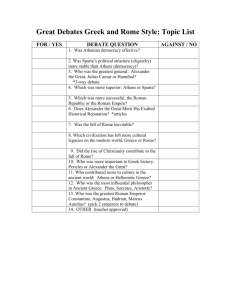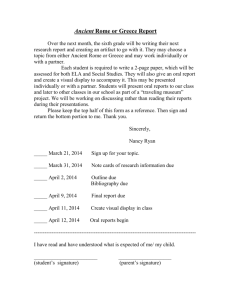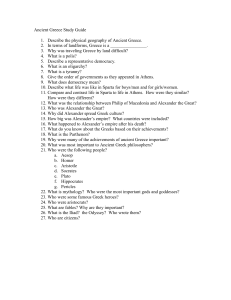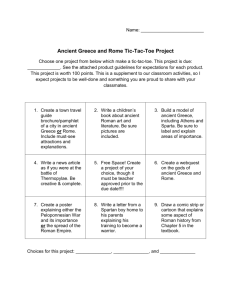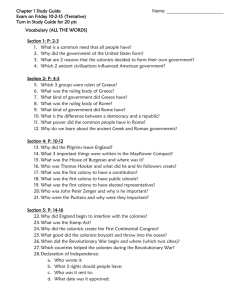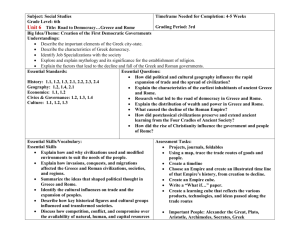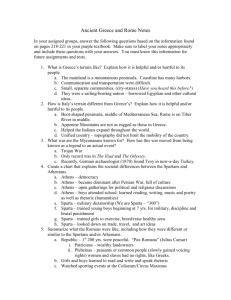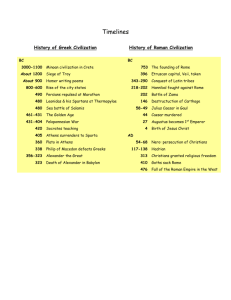Ms. Rush World History
advertisement
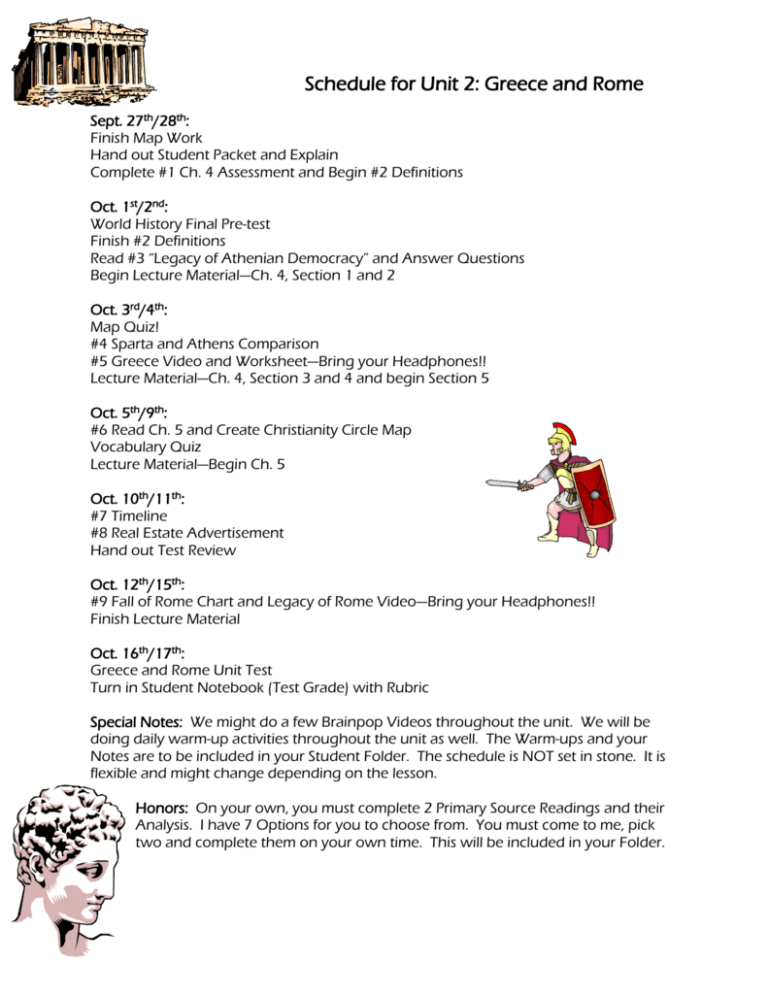
Schedule for Unit 2: Greece and Rome Sept. 27th/28th: Finish Map Work Hand out Student Packet and Explain Complete #1 Ch. 4 Assessment and Begin #2 Definitions Oct. 1st/2nd: World History Final Pre-test Finish #2 Definitions Read #3 “Legacy of Athenian Democracy” and Answer Questions Begin Lecture Material—Ch. 4, Section 1 and 2 Oct. 3rd/4th: Map Quiz! #4 Sparta and Athens Comparison #5 Greece Video and Worksheet—Bring your Headphones!! Lecture Material—Ch. 4, Section 3 and 4 and begin Section 5 Oct. 5th/9th: #6 Read Ch. 5 and Create Christianity Circle Map Vocabulary Quiz Lecture Material—Begin Ch. 5 Oct. 10th/11th: #7 Timeline #8 Real Estate Advertisement Hand out Test Review Oct. 12th/15th: #9 Fall of Rome Chart and Legacy of Rome Video—Bring your Headphones!! Finish Lecture Material Oct. 16th/17th: Greece and Rome Unit Test Turn in Student Notebook (Test Grade) with Rubric Special Notes: We might do a few Brainpop Videos throughout the unit. We will be doing daily warm-up activities throughout the unit as well. The Warm-ups and your Notes are to be included in your Student Folder. The schedule is NOT set in stone. It is flexible and might change depending on the lesson. Honors: On your own, you must complete 2 Primary Source Readings and their Analysis. I have 7 Options for you to choose from. You must come to me, pick two and complete them on your own time. This will be included in your Folder. World History Unit 2—Empires of the Ancient World: Greece and Rome (Ch. 4 and 5) Introduction: At first glance, it might seem puzzling that the people of the early Mediterranean area, the ancient Greeks and Romans, created two very important civilizations. Quarrelsome peoples, they could never agree among themselves for any length of time. The Greeks were not even great empire-builders, until the Age of Alexander. We take a special interest in them, however, because much of Western civilization had its foundations in early Greece and the Republic of Rome. For example, the early Greeks were the first people to experiment successfully with the idea that citizens could govern themselves, an idea that he United States and many other countries have since adopted and refined. Greek culture reached new heights during the 400s BC, a period so magnificent we call it the Golden Age. It may seem astonishing that in such a short time one group of people created so many enduring contributions in art, thought, and politics. In the 300s BC, an outside power, Macedonia, conquered the Greek city-states. Alexander the Great established a vast empire. By creating a much larger area within which Greek ideas and thought could thrive, Alexander made possible the development of the Hellenistic culture. Remarkable advances in philosophy, science, mathematics, medicine, and astronomy dramatically changed the way people thought. These achievements molded ideas about the physical universe and influenced Western civilization for centuries. In a sense, this Unit is also an exploration of over one thousand years of conquest and a comparison of two very different kinds of weapons: the military conquests of Rome and Greece versus the conquest of the world by religion, specifically Christianity. The date 146 BC is often given as the end of the Hellenistic Age because by that year the Romans had extended their power over a large part of the eastern Mediterranean. But who were the Greeks and the Romans? How did they each in turn become powerful enough to gain control of the entire Mediterranean region and much of Europe as well? And why are they important to us today? To answer these questions, you will look west of Greece to the settlement that would in time become the imperial city of Rome. In contrast to the genius of the Greeks, which lay in the development of philosophy, the genius of the Romans lay in politics and law. Even today we trace the origins of many of our legal and political institutions to those of ancient Rome. Almost side by side with Rome’s military conquest of the world, two of the world’s greatest religions – Judaism and Christianity – were conquering the world in their own way. As part of your look at world conquest, we will discuss these two great religions of the world. Requirements for Earning Credit for Unit 2: Read all of the instructions first and only then proceed to complete the learning activities in the order in which they are listed. To complete Unit 2, you must complete all of the learning activities in this Student Folder, as well as take notes during the seminars. You will also take a test at the end of the unit work and complete a map and a map quiz. Seminars and Daily Work: Empires of the Ancient World –Greece and Rome (PowerPoints and Lecture notes) Student Notebook Warm-ups and Journal Activities Quizzes Map Quiz Vocabulary Quiz Tests and Performance Tasks Student Project/Presentation—Timeline Test: Chapters 4 and 5 Student Folder—Counts as a Test Grade Learning Activities: A. Map: The Map requires that you fill in countries, bodies of water, civilizations, and cities. You must completely follow the directions and fill-in the map 100%! You will be graded on following directions and then again later you will be graded on the Map Test! B. Create the Student Notebook Cover Page for this Unit (Unit 2). a. Add the information called for in the illustration below. b. Illustrate the cover using words and pictures that explain the forms of republic (A republic is a form of democracy where representatives are elected to make the laws) used in Athens AND in early Rome. Use pages 120 in Chapter 4 for Athenian democracy and page 152-153 in Chapter 5 for the Roman Republic. Some websites you can use for pictures and information are: Athens: http://en.wikipedia.org/wiki/Athenian_democracy http://www.bbc.co.uk/history/ancient/greeks/greekdemocracy_01.shtml Rome: http://en.wikipedia.org/wiki/Roman_Republic http://www.vroma.org/~bmcmanus/romangvt.html http://www.worldbook.com/wb/Article?id=ar474350 The cover page should look like the page in Figure 1. No Clipart, please. Student Notebook Cover Page Empires of the Ancient World: Greece and Rome An Student Notebook for Unit 2: World History Ms. Rush Athenian Democracy Roman Republic By [Your first and last name] Date: (Deadline Date) Page 1 Figure 1 C. Student Folder. Complete the Student Folder activities in the following order. 1. Skim read Chapter 4, “Ancient Greece,” pages 109 -143. Complete the Ch. 4 Assessment on page 144, Answer Using Key Terms: #1-11, Reviewing Key Facts #12, 13, 15, 16, 17, 18, and 20, Critical Thinking #23. 2. Create Illustrated Dictionary Definitions for the words listed on the Illustrated Dictionary Definitions Chart. Write the definition in the same square as the word and put the drawings in the square opposite the definitions. Write a sentence from reading with the vocabulary word in the 3rd column. In the 4th column, fill in Who did this, why did they do this, or what did they do. Then add 2 words from Ch. 4 and 2 words from Ch. 5 that you think are important as well. Write the word, definition and draw a picture of those words. 3. Read “The Legacy of Athenian Democracy” in this unit and answer the questions at the bottom. Use this reading to help you complete your cover sheet. 4. Complete the chart for Spartan civilization and for Athenian civilization depicting information about life in each city state. Include information about a. the form of government and who could vote b. the military and who became soldiers c. education d. slavery e. attitudes toward art and philosophy f. the role of women and daily life i. Use pages 114 and 118-121 as well as your seminar notes. 5. Watch the video on Greece. Take good notes! Complete a Viewer’s Guide and complete the Discovering Ancient Greece Video Worksheet. I will give you the worksheet after you watch the video and take notes! You may use your notes on the Worksheet. 6. Skim read Chapter 5, Rome and the Rise of Christianity - pages 147-179. Create a Circle Map on which you label the center circle, “Christianity in the Roman Empire.” 7. Timeline Activity! Follow the directions for the Golden Age of Greece Timeline that you will find in this unit. This is a project you may work on with a group of two other students. (Completion time: ½ Class Period) 8. Real Estate Ad—Create a Real Estate Advertisement of Athenian Democracy that would encourage people to settle in Athens. Your ad is based on the idea that Athens has a superior government to that of Sparta or Persia and is, therefore a better place to live. Communicate why Athenian government is desirable. Illustrate your ad (by hand or on the computer) and be creative! 9. Create 2 Charts. One will discuss the Fall of Rome; the other will discuss the Legacy of Rome. a. The Fall of Rome chart should include 4 Sections: i. Political Causes ii. Economic Causes iii. Military Causes iv. Social Causes b. The Legacy of Rome—Watch the Rome Video i. Discuss at least 4 ways in which the legacy of the Roman Empire influences the community today. Use your book, your notes and the Rome Video. 10. Put your notes from the seminars in your folder and complete the rubric. Don’t forget to include your Journal/Warm-up Activities. Turn in your Student Folder the Day of the Test. D. Take the test over Chapters 4 and 5. Use the test review sheet you will receive from me in class to help you study for the test. 11. BONUS!!!! Create a sensory figure for (a sensory figure is a simple drawing or drawings of prominent historical figures with descriptions of what they might be seeing, hearing, saying, feeling, or doing—to show the thoughts, feelings, and experiences of historical figures): a. Julius Caesar (depicting information about Caesar’s life as a soldier in Gaul and in Egypt, as ruler of Rome and the reasons for his assassination.) b. When the sensory figures are complete, you should have 6 sentences. Use pages 157-158. c. Include in your Student Folder Honors: On your own, you must complete 2 Primary Source Readings and their Analysis. I have 7 Options for you to choose from. You must come to me, pick two and complete them on your own time. This will be included in your Folder. Name____________________________ Class period____________________________ Unit 2 Comparison Chart: Athens and Sparta Directions: Using the information from your peer tutoring readings in class and the information in your textbook, complete the comparison chart. Cultural Elements Who could vote? Who ran the government? Soldiers and the Military Slaves Women Education and the Arts Athens (Delian League) Sparta Timeline: Greece’s Golden Age Directions: Create a timeline in which you list the dates of the most important events in the history of ancient Greece. Use the following events. You will have to find the dates of these events in Chapter 5 in your textbook and using the reference links on the world history web site: http://www.hyperhistory.com/online_n2/History_n2/a.html Make sure the timeline is drawn to scale and that you include a legend for the scale. These events are not necessarily in chronological order! 1. Height of Minoan civilization 2. Homer composes the Iliad and the Odyssey 3. Persians conquer Asia Minor 4. Greeks defeat Persia in the Persian Wars. 5. Sparta and Athens fight the Peloponnesian War 6. Trojan War 7. Pericles builds the Parthenon in Athens 8. Alexander becomes king of Greece 9. Alexander defeats the Persian king, Darius 10. Death of Alexander 11. Death of Socrates 12. Defeat of the Greeks by Phillip of Macedonia 13. Alexander’s army reaches the Indus River valley 14. Hellenistic Age
